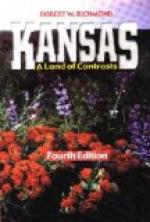than in objective theme. Miss Emily Dickinson
is still a name so unfamiliar to English readers that
I may be pardoned a few lines of biographical explanation.
She was born in 1830, the daughter of the leading lawyer
of Amherst, a small and quiet town of New England,
delightfully situated on a hill, looking out over
the undulating woods of the Connecticut valley.
It is a little larger than the English Marlborough,
and like it owes its distinctive tone to the presence
of an important educational institute, Amherst College
being one of the best-known and worthiest of the smaller
American colleges. In this quiet little spot
Miss Dickinson spent the whole of her life, and even
to its limited society she was almost as invisible
as a cloistered nun except for her appearances at
an annual reception given by her father to the dignitaries
of the town and college. There was no definite
reason either in her physical or mental health for
this life of extraordinary seclusion; it seems to
have been simply the natural outcome of a singularly
introspective temperament. She rarely showed
or spoke of her poems to any but one or two intimate
friends; only three or four were published during
her lifetime; and it was with considerable surprise
that her relatives found, on her death in 1886, a
large mass of poetical remains, finished and unfinished.
A considerable selection from them has been published
in three little volumes, edited with tender appreciation
by two of her friends, Mrs. Mabel Loomis Todd and
Col. T.W. Higginson.
Her poems are all in lyrical form—if the
word form may be applied to her utter disregard of
all metrical conventions. Her lines are rugged
and her expressions wayward to an extraordinary degree,
but “her verses all show a strange cadence of
inner rhythmical music,” and the “thought-rhymes”
which she often substitutes for the more regular assonances
appeal “to an unrecognised sense more elusive
than hearing” (Mrs. Todd). In this curious
divergence from established rules of verse Miss Dickinson
may be likened to Walt Whitman, whom she differs from
in every other particular, and notably in her pithiness
as opposed to his diffuseness; but with her we feel
in the strongest way that her mode is natural and
unsought, utterly free from affectation, posing, or
self-consciousness.
Colonel Higginson rightly finds her nearest analogue
in William Blake; but this “nearest” is
far from identity. While tenderly feminine in
her sympathy for suffering, her love of nature, her
loyalty to her friends, she is in expression the most
unfeminine of poets. The usual feminine impulsiveness
and full expression of emotion is replaced in her
by an extraordinary condensation of phrase and feeling.
In her letters we find the eternal womanly in her
yearning love for her friends, her brooding anxiety
and sympathy for the few lives closely intertwined
with her own. In her poems, however, one is rather
impressed with the deep well of poetic insight and




